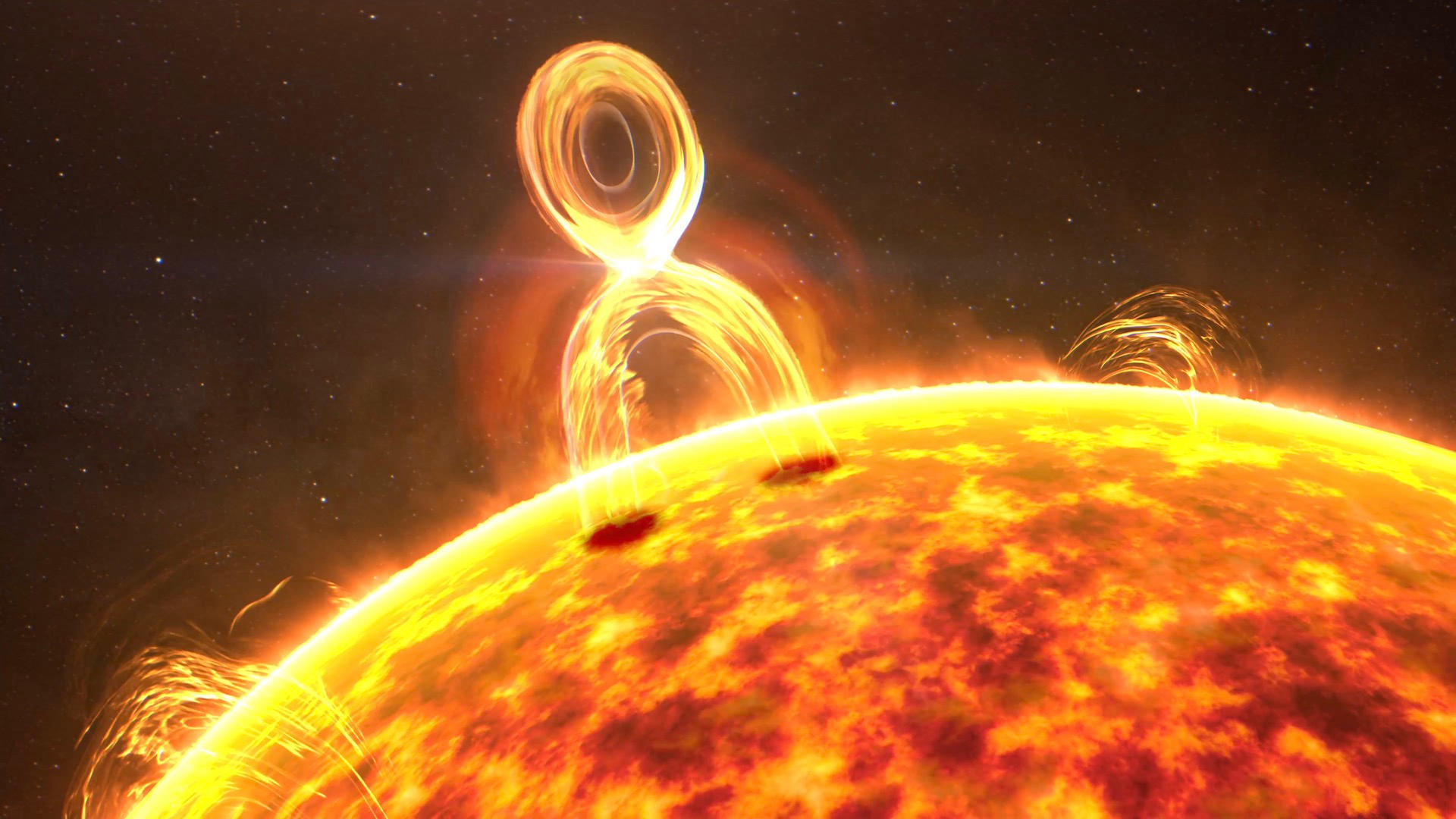Cuplikan layar dari Lab Gambar Konseptual NASA tentang Rekoneksi Magnetik di Seluruh Tata Surya. Penyambungan ulang magnetik terjadi ketika medan magnet antiparalel — yang ditemukan dalam semburan matahari dalam kasus ini — bertabrakan, pecah, dan meluruskan kembali. Proses tersebut menciptakan ledakan berenergi tinggi yang melontarkan partikel ke angkasa. Kredit gambar: Lab Gambar Konseptual NASA
Para ilmuwan menggunakan sinar laser yang kuat untuk membuat suar matahari mini untuk mempelajari proses rekoneksi magnetik.
Para ilmuwan menggunakan dua belas sinar laser berkekuatan tinggi untuk mensimulasikan suar matahari mini untuk mempelajari mekanisme yang mendasari penyambungan kembali magnetik, sebuah fenomena astronomi yang mendasar.
Berlawanan dengan kepercayaan populer, alam semesta tidak kosong. Terlepas dari frasa “kekosongan ruang yang luas”, alam semesta penuh dengan berbagai zat seperti partikel bermuatan, gas, dan sinar kosmik. Sementara benda langit tampak langka, alam semesta penuh dengan aktivitas.
Salah satu pendorong partikel dan energi melalui ruang angkasa adalah fenomena yang disebut rekoneksi magnetik. Seperti namanya, rekoneksi magnetik terjadi ketika dua medan magnet antiparalel – seperti dua medan magnet yang berlawanan arah – bertabrakan, pecah, dan meluruskan kembali. Tidak berbahaya kedengarannya, itu sama sekali bukan proses yang tenang.
“Fenomena ini bisa dilihat di mana-mana di alam semesta. Di rumah, Anda dapat melihatnya di jilatan api matahari atau di magnetosfer Bumi. Saat jilatan api matahari terbentuk dan jilatan api tampaknya ‘menyerang’, itu adalah rekoneksi magnetik,” jelas Taichi Morita, asisten profesor di Universitas Kyushu Fakultas Teknik dan penulis pertama studi ini. “Faktanya, aurora terbentuk sebagai hasil dari partikel bermuatan yang dikeluarkan dari rekoneksi magnetik di medan magnet Bumi.”
Meskipun sering terjadi, banyak mekanisme di balik fenomena tersebut tetap menjadi misteri. Studi dilakukan seperti[{” attribute=””>NASA’s Magnetospheric Multiscale Mission, where magnetic reconnections are studied in real-time by satellites sent into Earth’s magnetosphere. However, things such as the speed of reconnection or how energy from the magnetic field is converted and distributed to the particles in the plasma remain unexplained.
An alternative to sending satellites into space is to use lasers and artificially generate plasma arcs that produce magnetic reconnections. However, without suitable laser strength, the generated plasma is too small and unstable to study the phenomena accurately.
“One facility that has the required power is Osaka University’s Institute for Laser Engineering and their Gekko XII laser. It’s a massive 12-beam, high-powered laser that can generate plasma stable enough for us to study,” explains Morita. “Studying astrophysical phenomena using high-energy lasers is called ‘laser astrophysics experiments,’ and it has been a developing methodology in recent years.”
In their experiments, reported in Physical Review E, the high-power lasers were used to generate two plasma fields with anti-parallel magnetic fields. The team then focused a low-energy laser into the center of the plasma where the magnetic fields would meet and where magnetic reconnection would theoretically occur.
“We are essentially recreating the dynamics and conditions of a solar flare. Nonetheless, by analyzing how the light from that low-energy laser scatters, we can measure all sorts of parameters from plasma temperature, velocity, ion valence, current, and plasma flow velocity,” continues Morita.
One of their key findings was recording the appearance and disappearance of electrical currents where the magnetic fields met, indicating magnetic reconnection. Additionally, they were able to collect data on the acceleration and heating of the plasma.
The team plans on continuing their analysis and hopes that these types of ‘laser astrophysics experiments’ will be more readily used as an alternative or complementary way to investigate astrophysical phenomena.
“This method can be used to study all sorts of things like astrophysical shockwaves, cosmic-ray acceleration, and magnetic turbulence. Many of these phenomena can damage and disrupt electrical devices and the human body,” concludes Morita. “So, if we ever want to be a spacefaring race, we must work to understand these common cosmic events.”
Reference: “Detection of current-sheet and bipolar ion flows in a self-generated antiparallel magnetic field of laser-produced plasmas for magnetic reconnection research” by T. Morita, T. Kojima, S. Matsuo, S. Matsukiyo, S. Isayama, R. Yamazaki, S. J. Tanaka, K. Aihara, Y. Sato, J. Shiota, Y. Pan, K. Tomita, T. Takezaki, Y. Kuramitsu, K. Sakai, S. Egashira, H. Ishihara, O. Kuramoto, Y. Matsumoto, K. Maeda and Y. Sakawa, 10 November 2022, Physical Review E.
DOI: 10.1103/PhysRevE.106.055207
The study was funded by the Japan Society for the Promotion of Science.

“Ninja twitter bersertifikat. Ahli internet. Penggemar budaya pop hardcore. Baconaholic.”
You may also like
-
Aturan matematika ditemukan di balik distribusi neuron di otak kita
-
Para ilmuwan menemukan penjelasan untuk lubang gravitasi raksasa di Samudra Hindia
-
Peta baru yang akurat dari semua materi di alam semesta dirilis
-
Para ilmuwan mengatakan sepasang bintang yang sangat langka berperilaku sangat ‘aneh’
-
Lima Angsa Tewas Setelah Terbang Ke Saluran Listrik Hinkley | Berita Inggris

